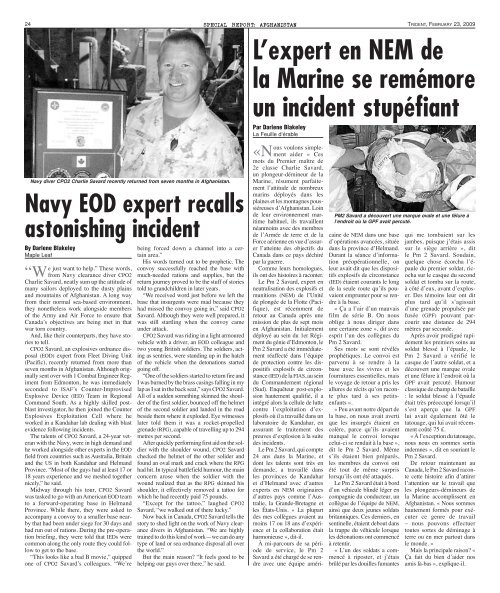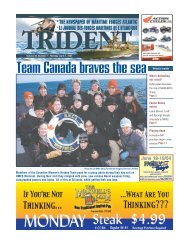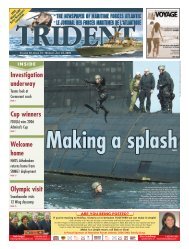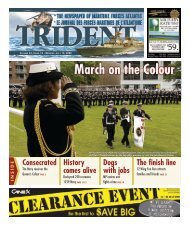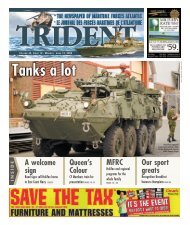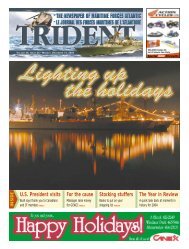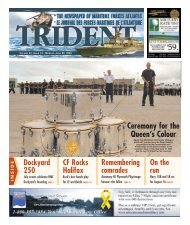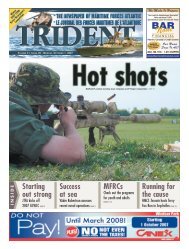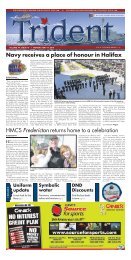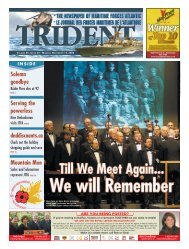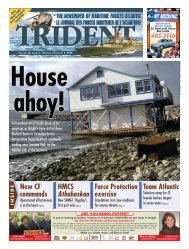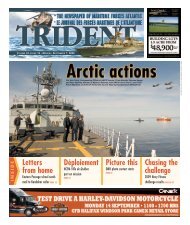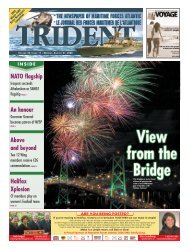February 23, 2009 - Tridentnews.ca
February 23, 2009 - Tridentnews.ca
February 23, 2009 - Tridentnews.ca
- No tags were found...
Create successful ePaper yourself
Turn your PDF publications into a flip-book with our unique Google optimized e-Paper software.
24<br />
SPECIAL REPORT: AFGHANISTAN<br />
TRIDENT, FEBRUARY <strong>23</strong>, <strong>2009</strong><br />
L’expert en NEM de<br />
la Marine se remémore<br />
un incident stupéfiant<br />
Navy diver CPO2 Charlie Savard recently returned from seven months in Afghanistan.<br />
Navy EOD expert re<strong>ca</strong>lls<br />
astonishing incident<br />
By Darlene Blakeley<br />
Maple Leaf<br />
e just want to help.” These words,<br />
“Wfrom Navy clearance diver CPO2<br />
Charlie Savard, neatly sum up the attitude of<br />
many sailors deployed to the dusty plains<br />
and mountains of Afghanistan. A long way<br />
from their normal sea-based environment,<br />
they nonetheless work alongside members<br />
of the Army and Air Force to ensure that<br />
Canada’s objectives are being met in that<br />
war torn country.<br />
And, like their counterparts, they have stories<br />
to tell.<br />
CPO2 Savard, an explosives ordnance disposal<br />
(EOD) expert from Fleet Diving Unit<br />
(Pacific), recently returned from more than<br />
seven months in Afghanistan. Although originally<br />
sent over with 1 Combat Engineer Regiment<br />
from Edmonton, he was immediately<br />
seconded to ISAF’s Counter-Improvised<br />
Explosive Device (IED) Team in Regional<br />
Command South. As a highly skilled postblast<br />
investigator, he then joined the Counter<br />
Explosives Exploitation Cell where he<br />
worked in a Kandahar lab dealing with blast<br />
evidence following incidents.<br />
The talents of CPO2 Savard, a 24-year veteran<br />
with the Navy, were in high demand and<br />
he worked alongside other experts in the EOD<br />
field from countries such as Australia, Britain<br />
and the US in both Kandahar and Helmand<br />
Province. “Most of the guys had at least 17 or<br />
18 years experience and we meshed together<br />
nicely,” he said.<br />
Midway through his tour, CPO2 Savard<br />
was tasked to go with an Ameri<strong>ca</strong>n EOD team<br />
to a forward-operating base in Helmand<br />
Province. While there, they were asked to<br />
accompany a convoy to a smaller base nearby<br />
that had been under siege for 30 days and<br />
had run out of rations. During the pre-operation<br />
briefing, they were told that IEDs were<br />
common along the only route they could follow<br />
to get to the base.<br />
“This looks like a bad B movie,” quipped<br />
one of CPO2 Savard’s colleagues. “We’re<br />
being forced down a channel into a certain<br />
area.”<br />
His words turned out to be prophetic. The<br />
convoy successfully reached the base with<br />
much-needed rations and supplies, but the<br />
return journey proved to be the stuff of stories<br />
told to grandchildren in later years.<br />
“We received word just before we left the<br />
base that insurgents were mad be<strong>ca</strong>use they<br />
had missed the convoy going in,” said CPO2<br />
Savard. Although they were well prepared, it<br />
was still startling when the convoy <strong>ca</strong>me<br />
under attack.<br />
CPO2 Savard was riding in a light armoured<br />
vehicle with a driver, an EOD colleague and<br />
two young British soldiers. The soldiers, acting<br />
as sentries, were standing up in the hatch<br />
of the vehicle when the detonations started<br />
going off.<br />
“One of the soldiers started to return fire and<br />
I was burned by the brass <strong>ca</strong>sings falling in my<br />
lap as I sat in the back seat,” says CPO2 Savard.<br />
All of a sudden something skinned the shoulder<br />
of the first soldier, bounced off the helmet<br />
of the second soldier and landed in the road<br />
beside them where it exploded. Eye witnesses<br />
later told them it was a rocket-propelled<br />
grenade (RPG), <strong>ca</strong>pable of travelling up to 294<br />
metres per second.<br />
After quickly performing first aid on the soldier<br />
with the shoulder wound, CPO2 Savard<br />
checked the helmet of the other solider and<br />
found an oval mark and crack where the RPG<br />
had hit. In typi<strong>ca</strong>l battlefield humour, the main<br />
concern arose when the soldier with the<br />
wound realized that as the RPG skinned his<br />
shoulder, it effectively removed a tattoo for<br />
which he had recently paid 75 pounds.<br />
“Except for the tattoo,” laughed CPO2<br />
Savard, “we walked out of there lucky.”<br />
Now back in Canada, CPO2 Savard tells the<br />
story to shed light on the work of Navy clearance<br />
divers in Afghanistan. “We are highly<br />
trained to do this kind of work—we <strong>ca</strong>n do any<br />
type of land or sea ordnance disposal all over<br />
the world.”<br />
But the main reason “It feels good to be<br />
helping our guys over there,” he said.<br />
PM2 Savard a découvert une marque ovale et une fêlure à<br />
l’endroit où la GPF avait percuté.<br />
Par Darlene Blakeley<br />
La Feuille d’érable<br />
ous voulons simple-<br />
aider » Ces «Nment<br />
mots du Premier maître de<br />
2e classe Charlie Savard,<br />
un plongeur-démineur de la<br />
Marine, résument parfaitement<br />
l’attitude de nombreux<br />
marins déployés dans les<br />
plaines et les montagnes poussiéreuses<br />
d’Afghanistan. Loin<br />
de leur environnement maritime<br />
habituel, ils travaillent<br />
néanmoins avec des membres<br />
de l’Armée de terre et de la<br />
Force aérienne en vue d’assurer<br />
l’atteinte des objectifs du<br />
Canada dans ce pays déchiré<br />
par la guerre.<br />
Comme leurs homologues,<br />
ils ont des histoires à raconter.<br />
Le Pm 2 Savard, expert en<br />
neutralisation des explosifs et<br />
munitions (NEM) de l’Unité<br />
de plongée de la Flotte (Pacifique),<br />
est récemment de<br />
retour au Canada après une<br />
mission de plus de sept mois<br />
en Afghanistan. Initialement<br />
déployé au sein du 1er Régiment<br />
du génie d’Edmonton, le<br />
Pm 2 Savard a été immédiatement<br />
réaffecté dans l’équipe<br />
de protection contre les dispositifs<br />
explosifs de circonstance<br />
(IED) de la FIAS, au sein<br />
du Commandement régional<br />
(Sud). Enquêteur post-explosion<br />
hautement qualifié, il a<br />
intégré alors la cellule de lutte<br />
contre l’exploitation d’explosifs<br />
où il a travaillé dans un<br />
laboratoire de Kandahar, en<br />
assurant le traitement des<br />
preuves d’explosion à la suite<br />
des incidents.<br />
Le Pm 2 Savard, qui compte<br />
24 ans dans la Marine, et<br />
dont les talents sont très en<br />
demande, a travaillé dans<br />
les provinces de Kandahar<br />
et d’Helmand avec d’autres<br />
experts en NEM originaires<br />
d’autres pays comme l’Australie,<br />
la Grande-Bretagne et<br />
les États-Unis. « La plupart<br />
des mes collègues avaient au<br />
moins 17 ou 18 ans d’expérience<br />
et la collaboration était<br />
harmonieuse », dit-il.<br />
À mi-parcours de sa période<br />
de service, le Pm 2<br />
Savard a été chargé de se rendre<br />
avec une équipe améri<strong>ca</strong>ine<br />
de NEM dans une base<br />
d’opérations avancées, située<br />
dans la province d’Helmand.<br />
Durant la séance d’information<br />
préopérationnelle, on<br />
leur avait dit que les dispositifs<br />
explosifs de circonstance<br />
(IED) étaient courants le long<br />
de la seule route qu’ils pouvaient<br />
emprunter pour se rendre<br />
à la base.<br />
« Ça a l’air d’un mauvais<br />
film de série B. On nous<br />
oblige à nous diriger dans<br />
une certaine zone », dit avec<br />
esprit l’un des collègues du<br />
Pm 2 Savard.<br />
Ses mots se sont révélés<br />
prophétiques. Le convoi est<br />
parvenu à se rendre à la<br />
base avec les vivres et les<br />
fournitures essentielles, mais<br />
le voyage de retour a pris les<br />
allures de récits qu’on raconte<br />
plus tard à ses petitsenfants<br />
».<br />
« Peu avant notre départ de<br />
la base, on nous avait averti<br />
que les insurgés étaient en<br />
colère, parce qu’ils avaient<br />
manqué le convoi lorsque<br />
celui-ci se rendait à la base »,<br />
dit le Pm 2 Savard. Même<br />
s’ils étaient bien préparés,<br />
les membres du convoi ont<br />
été tout de même surpris<br />
lorsqu’ils ont été attaqués.<br />
Le Pm 2 Savard était à bord<br />
d’un véhicule blindé léger en<br />
compagnie du conducteur, un<br />
collègue de l’équipe de NEM,<br />
ainsi que deux jeunes soldats<br />
britanniques. Ces derniers, en<br />
sentinelle, étaient debout dans<br />
la trappe du véhicule lorsque<br />
les détonations ont commencé<br />
à retentir.<br />
« L’un des soldats a commencé<br />
à riposter, et j’étais<br />
brûlé par les douilles fumantes<br />
qui me tombaient sur les<br />
jambes, puisque j’étais assis<br />
sur le siège arrière », dit<br />
le Pm 2 Savard. Soudain,<br />
quelque chose écorcha l’épaule<br />
du premier soldat, ricocha<br />
sur le <strong>ca</strong>sque du second<br />
soldat et tomba sur la route,<br />
à côté d’eux, avant d’exploser.<br />
Des témoins leur ont dit<br />
plus tard qu’il s’agissait<br />
d’une grenade propulsée par<br />
fusée (GPF) pouvant parcourir<br />
une distance de 294<br />
mètres par seconde.<br />
Après avoir prodigué rapidement<br />
les premiers soins au<br />
soldat blessé à l’épaule, le<br />
Pm 2 Savard a vérifié le<br />
<strong>ca</strong>sque de l’autre soldat, et a<br />
découvert une marque ovale<br />
et une fêlure à l’endroit où la<br />
GPF avait percuté. Humour<br />
classique de champ de bataille<br />
: le soldat blessé à l’épaule<br />
était très préoccupé lorsqu’il<br />
s’est aperçu que la GPF<br />
lui avait également ôté le<br />
tatouage, qui lui avait récemment<br />
coûté 75 £.<br />
« À l’exception du tatouage,<br />
nous nous en sommes sortis<br />
indemnes », dit en souriant le<br />
Pm 2 Savard.<br />
De retour maintenant au<br />
Canada, le Pm 2 Savard raconte<br />
cette histoire afin d’attirer<br />
l’attention sur le travail que<br />
les plongeurs-démineurs de<br />
la Marine accomplissent en<br />
Afghanistan. « Nous sommes<br />
hautement formés pour exécuter<br />
ce genre de travail<br />
– nous pouvons effectuer<br />
toutes sortes de déminage à<br />
terre ou en mer partout dans<br />
le monde. »<br />
Mais la principale raison «<br />
Ça fait du bien d’aider nos<br />
amis là-bas », explique-il.


